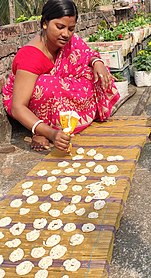Bori (food)
 Bori | |
| Type | Dumpling |
|---|---|
| Place of origin | India |
| Region or state | Purba Medinipur, West Bengal |
| Associated national cuisine | India |
| Main ingredients | Cowpea, Dal, Poppy seed and various type of Spices |
| Variations | Gohona Bori |
Bori (Bengali: বড়ি) is a form of dried lentil dumplings popular in Bengali cuisine. It is made from a paste of urad dal and winter melon which is sun-dried for 3–5 days. Once fully dried, it can easily last for about a year.[1]
Recipe[edit]
The paste is laid out by hand on a mat in the sunlight. It sticks to the mat while wet but when the bori dries completely it can easily come off. In its simplest form bori takes the conical shape naturally occurring due to the way the paste is laid out.[2]
Intricate artistic designs can also made with the paste when squeezed out through a piping bag. This is called naksha bori. It is also called gohona bori or gayna bori because the designs often look like those of jewellery (gahana or gayna is Bengali for jewellery). To avoid breaking naksha bori when removing from the mat, a layer of poppy seeds is spread before laying the paste. The district of Purba Medinipur is famous for its naksha bori.[3] Preparing bori is almost exclusively done by women of the household, sometimes assisted by children. Contrary to the common notion, it is not grown on trees.[4]
Consumption[edit]
Bori can be fried and eaten as a snack or can be added to fish or vegetable dishes to enhance taste and to add variety.
See also[edit]
References[edit]
- ↑ "How British greed spurred the creation of one of Bengal's most loved dishes". The Indian Express. 2016-03-31. Retrieved 2019-03-12.
- ↑ IANS (2016-07-31). "IIT Kharagpur facilitating filing of GI application for 'Goyna Bori'". Business Standard India. Retrieved 2019-03-12.
- ↑ Ray, Utsa (2015-01-05). Culinary culture in colonial India. Cambridge University Press. p. 227. ISBN 978-1107042810.
- ↑ Bhowmik, Arindam. Medinikatha - Purba Medinipur (Midnapore), Tourism & Archaeology (মেদিনীকথা - পূর্ব মেদিনীপুর, পর্যটন ও পুরাকীর্তি): Combination of History, Heritage, Tourism, Culture of East Midnapore (in Bengali). Arindam Bhowmik. ISBN 9788193189238.

